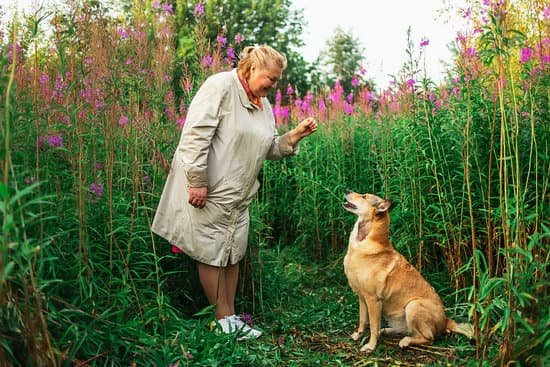Training an old dog to walk on a leash can be a challenging but rewarding experience. It requires patience, understanding, and the right approach to ensure that your elderly canine companion can enjoy the benefits of regular walks. In this article, we will explore the specific challenges of training an older dog to walk on a leash and provide helpful tips and techniques to make the process easier for both you and your furry friend.
As our beloved dogs age, they may develop physical limitations and behavioral issues that can make leash training more complicated. Assessing your old dog’s physical abilities and limitations is the first step in developing an appropriate training plan. Choosing the right leash and collar for an elderly dog is also crucial to ensure their comfort and safety during walks.
In addition, patience and consistency are essential when training an old dog to walk on a leash. Understanding the unique needs of older dogs and implementing positive reinforcement techniques can make a significant difference in their ability to learn new behaviors.
We will discuss these techniques in detail and provide guidance on dealing with behavioral issues and distractions during leash training. By incorporating positive reinforcement and rewards into the training process, you can make walking on a leash a positive experience for your older dog.
Assessing Your Old Dog’s Physical Abilities and Limitations
Understanding Your Old Dog’s Physical Limitations
Older dogs may have various physical limitations and health issues that can affect their ability to walk on a leash. It’s important to assess your old dog’s physical condition before starting leash training. Arthritis, joint pain, reduced mobility, and other age-related ailments can impact your dog’s walking abilities. Take note of any signs of discomfort or fatigue during short walks around the house or yard.
Consulting With a Veterinarian
Before embarking on leash training for your old dog, it’s crucial to consult with a veterinarian. A professional evaluation will help you understand any specific physical limitations your older dog may have. The vet can provide guidance on suitable exercises, appropriate leash and collar options, and potential modifications to the training process based on your dog’s individual needs.
Adapting the Training Approach
Once you have a clear understanding of your old dog’s physical abilities and limitations, you can adjust your training approach accordingly. This may involve modifying the intensity and duration of training sessions, incorporating more frequent breaks during walks, or choosing gentle walking surfaces to minimize joint strain. Understanding and accommodating your old dog’s physical challenges is essential for a successful leash training experience.
By considering these factors before beginning leash training for an older dog, you can ensure a safe and effective process that takes into account your furry friend’s unique needs.
Choosing the Right Leash and Collar for an Elderly Dog
As your dog gets older, it’s important to take into consideration their physical limitations and comfort when choosing the right leash and collar for them. Here are some tips to ensure your elderly dog’s safety and comfort while walking on a leash:
- Consider a harness: For older dogs, especially those with arthritis or mobility issues, using a harness instead of a collar can be more comfortable. A harness distributes the pressure from the leash across the dog’s chest and back, reducing strain on their neck and throat.
- Opt for a lightweight leash: Choose a lightweight leash that is easy for your elderly dog to handle. A heavy or thick leash can be cumbersome and may cause discomfort for an older dog with reduced strength and mobility. Look for a durable yet lightweight material such as nylon or leather.
- Choose a gentle leader or head halter: If your senior dog tends to pull or lunge while walking, consider using a gentle leader or head halter. These tools gently guide your dog’s head in the direction you want them to go, without causing discomfort or strain on their neck.
Remember that every dog is unique, so it’s essential to assess your old dog’s specific needs and comfort level before deciding on the right leash and collar for them. Taking these factors into account will make the training process much easier and more enjoyable for both you and your elderly canine companion.
When selecting the perfect equipment do not forget personalization. Like humans each dogs has his own personality, personal preference is indispensable when looking out for thee most suitable accessory in any given situation.
Eventually learning how to train an old dog to walk on leash might seem like an impossible task mainly because they have been used this treatment unpleasatant treatment at younger age. When handling this kind of training patience and encouragement are necessary attributes at hand.
Including these choices in order to help maximize result needed effort whenever required though this required one morphs under repetition – always remember haste makes waste so don’t try rushing phase whenever accompanying ones pet.
Patience and Consistency
When it comes to training an old dog to walk on a leash, patience and consistency are key. Older dogs may have physical limitations or behavioral issues that make leash training more challenging than it would be for a younger dog. However, with the right approach and a commitment to consistency, it is possible to teach an older dog to walk on a leash comfortably and safely.
Here are some essential tips for training an old dog to walk on a leash:
1. Set realistic expectations: Understand that it may take longer for an older dog to learn new behaviors, including walking on a leash. Be patient and prepared for the process to take time.
2. Establish a consistent routine: Older dogs thrive on routine, so be sure to establish a regular schedule for leash training sessions. Consistency will help your old dog understand what is expected of them.
3. Use gentle guidance: When teaching an old dog to walk on a leash, use gentle guidance rather than force. Avoid pulling or yanking on the leash, as this can cause discomfort or anxiety for your elderly canine companion.
By following these tips and approaching the training process with patience and consistency, you can help your old dog learn how to walk on a leash in a way that is comfortable and enjoyable for both of you.
– Take things slow: Older dogs may need more time to adjust to the sensation of wearing a collar and being attached to a leash. Start by allowing your old dog to become familiar with the collar and leash in the comfort of their own home before venturing outside for walks.
– Offer plenty of praise: When your older dog makes progress during leash training, be sure to offer plenty of praise and rewards. Positive reinforcement can help motivate your elderly pup and make the training process more enjoyable for them.
– Stay patient and persistent: It’s important not to get discouraged if progress is slow or if there are setbacks along the way. With patience and persistence, even older dogs can learn new skills like walking on a leash with time and dedication.
Techniques for Teaching an Old Dog to Walk on a Leash
As a dog ages, it may become more challenging to teach them new behaviors, including walking on a leash. However, with the right techniques and patience, it is possible to successfully train an older dog to walk on a leash.
Gradual Introduction
One of the most effective techniques for teaching an old dog to walk on a leash is to introduce the equipment gradually. Start by allowing your dog to get used to wearing the collar or harness around the house before attaching the leash. This will help your dog become comfortable with the sensation of wearing the equipment before adding the constraint of being attached to you.
Positive Reinforcement
Using positive reinforcement can be particularly effective when training an older dog. Reward your dog with treats, praise, and affection when they exhibit desired behaviors such as walking calmly on the leash without pulling. Positive reinforcement helps reinforce good behavior and makes the training process more enjoyable for your elderly canine companion.
Consistency and Patience
Consistency is key when training an older dog to walk on a leash. It’s important to remain patient and consistent in your training efforts, even if progress is slow. Older dogs may take longer to learn new behaviors, so it’s crucial to stay committed and maintain a positive attitude throughout the training process.
Dealing With Behavioral Issues and Distractions During Leash Training
As with any type of dog training, dealing with behavioral issues and distractions during leash training can be a challenge, especially when working with an older dog. This section will provide tips and techniques for handling common issues that may arise during leash training, as well as ways to minimize distractions for your older furry friend.
One of the key aspects of addressing behavioral issues during leash training is to remain patient and consistent. Older dogs may have developed habits over the years that are hard to break, so it’s important to approach the training process with understanding and a positive attitude. Consistency in your commands and expectations will also play a crucial role in helping your old dog learn to walk on a leash.
Another important aspect is to address any physical discomfort or limitations that your older dog may have while walking on a leash. This can include joint pain, arthritis, or other age-related conditions. Choosing the right type of collar or harness that is comfortable for your elderly pup is crucial for their overall well-being during walks.
It’s also essential to minimize distractions when training an older dog to walk on a leash. This can include finding quiet and familiar locations for training sessions, as well as using treats or toys as positive reinforcements for good behavior. By minimizing distractions, you can help your older dog focus on learning how to walk on a leash without feeling overwhelmed or anxious.
Incorporating Positive Reinforcement and Rewards Into the Training Process
As with any dog training, positive reinforcement and rewards play a crucial role in teaching an old dog to walk on a leash. This method involves rewarding your furry friend for displaying the desired behavior, in this case, walking calmly on a leash. Positive reinforcement can include verbal praise, treats, or even a favorite toy as a reward for good behavior.
When incorporating positive reinforcement into the training process, it’s important to use high-value treats that are especially enticing for your older dog. Soft and easy-to-chew treats may be preferable for elderly dogs with dental issues or limited jaw strength. Additionally, keeping training sessions short and frequent can help to maintain your dog’s interest and motivation.
Consistency is key when implementing positive reinforcement during leash training. It’s essential to reward your old dog immediately after they exhibit the desired behavior of walking calmly on the leash. Over time, as your pet becomes accustomed to walking on the leash, you can gradually reduce the frequency of treat rewards while still providing verbal praise as positive reinforcement.
Incorporating positive reinforcement and rewards into the training process not only helps motivate your older dog but also strengthens the bond between you and your pet. With patience and consistency, along with the use of high-value treats and verbal praise, you can effectively train an old dog to walk on a leash while maintaining their physical comfort and well-being.
| Positive Reinforcement | Rewards |
|---|---|
| Verbal praise | High-value treats |
| Consistency | Frequent short training sessions |
| Strengthen bond with your pet | Maintain physical comfort during training |
Taking Care of an Older Dog’s Physical Comfort While Walking
As our dogs age, they may start to experience physical limitations that can make walking more challenging for them. When training an older dog to walk on a leash, it’s important to take their physical comfort into consideration. This includes understanding the challenges they may face and making adjustments to ensure that the walking experience is as comfortable as possible for them.
One of the first steps in taking care of an older dog’s physical comfort while walking is to assess their individual needs and limitations. This may include considering any joint pain or arthritis they may be experiencing, as well as any mobility issues they may have. By understanding their specific needs, you can make necessary adjustments to their walking routine to accommodate them.
In addition, choosing the right leash and collar for an elderly dog is crucial in ensuring their physical comfort while walking. For example, using a harness instead of a traditional collar can help distribute pressure more evenly across their body, reducing strain on their neck and throat.
Additionally, opting for a leash with some give or elasticity can also help reduce any sudden jerks or pulls that may cause discomfort for an older dog. By making these adjustments, you can help make the walking experience more comfortable and enjoyable for your senior canine companion.
Finally, it’s important to be attentive to your older dog’s physical cues while out on a walk. Pay attention to signs of discomfort or fatigue, and be prepared to adjust your pace or route accordingly. By prioritizing your old dog’s physical comfort during walks and making necessary accommodations, you can help ensure that they continue to enjoy their time outdoors while staying safe and comfortable.
Seeking Professional Help and Assistance for Leash Training an Older Dog
In conclusion, training an old dog to walk on a leash can be a challenging but rewarding process. Understanding the challenges and limitations that come with age is crucial in approaching this task with patience and empathy. Assessing your old dog’s physical abilities and choosing the right equipment, such as a comfortable leash and collar, are important considerations before beginning the training process.
Patience and consistency are essential when training an older dog to walk on a leash. It is important to remember that it may take more time for an elderly dog to learn new behaviors, so being patient and maintaining a consistent training routine is key. Additionally, incorporating positive reinforcement and rewards into the training process can make the experience more enjoyable for both you and your old dog.
It is also important to address any behavioral issues or distractions that may arise during leash training. Finding techniques that work best for your specific dog and seeking professional help if needed can greatly improve the success of the training process. Overall, with dedication, understanding, and the right approach, it is possible to train an old dog to walk on a leash in a safe and enjoyable manner.
Frequently Asked Questions
Why Won’t My Old Dog Walk on the Lead?
There could be several reasons why your old dog refuses to walk on a lead. It could be due to physical discomfort or pain, fear or anxiety, a negative association with the leash, or simply old age and tiredness.
How Do You Train a Stubborn Dog to Walk on a Leash?
Training a stubborn dog to walk on a leash requires patience and consistency. Start by getting your dog used to wearing the leash and collar at home, then gradually transition to short walks in a familiar environment. Use positive reinforcement and rewards to encourage good behavior.
What to Do if Your Dog Won’t Walk on a Leash?
If your dog won’t walk on a leash, it’s important to rule out any medical issues by consulting with a veterinarian. Once you’ve confirmed that there are no physical problems, work on building positive associations with the leash using treats, praise, and gentle encouragement.
Gradually increase the length and complexity of walks as your dog becomes more comfortable.

Welcome to the blog! I am a professional dog trainer and have been working with dogs for many years. In this blog, I will be discussing various topics related to dog training, including tips, tricks, and advice. I hope you find this information helpful and informative. Thanks for reading!





